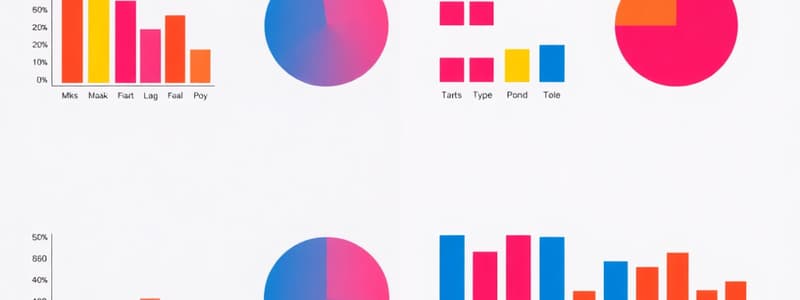Podcast
Questions and Answers
What is a significant disadvantage of participant observation research?
What is a significant disadvantage of participant observation research?
- The researcher loses objectivity due to involvement. (correct)
- The researcher remains fully objective throughout the study.
- Participant observation does not provide valuable insights.
- The research cannot be conducted in natural settings.
Which type of observation involves the researcher observing a group from a distance without participating?
Which type of observation involves the researcher observing a group from a distance without participating?
- Systematic controlled observation
- Structured observational study
- Non controlled, participant observation
- Non controlled non participant observation (correct)
What defines a structured (closed) questionnaire?
What defines a structured (closed) questionnaire?
- It consists of predetermined and rigid response options. (correct)
- It is primarily used for qualitative data collection.
- It allows respondents to provide detailed narrative answers.
- It includes open-ended questions for flexible responses.
What is the key feature of systematic controlled observation?
What is the key feature of systematic controlled observation?
According to Wallace and Wallace, what is a questionnaire primarily used for?
According to Wallace and Wallace, what is a questionnaire primarily used for?
What is the primary distinction between quantitative and qualitative data?
What is the primary distinction between quantitative and qualitative data?
Which of the following best describes primary data?
Which of the following best describes primary data?
Which of the following is NOT a method of data collection mentioned?
Which of the following is NOT a method of data collection mentioned?
Secondary data can include which of the following types of materials?
Secondary data can include which of the following types of materials?
What is the significance of data collection according to the content provided?
What is the significance of data collection according to the content provided?
What characterizes an unstructured questionnaire?
What characterizes an unstructured questionnaire?
Which type of interview is characterized by flexibility in questioning?
Which type of interview is characterized by flexibility in questioning?
What is the primary focus of a repeated interview?
What is the primary focus of a repeated interview?
Which type of interview limits its focus based on relevant theory and evidence?
Which type of interview limits its focus based on relevant theory and evidence?
What distinguishes a depth interview from other interview types?
What distinguishes a depth interview from other interview types?
In what way do surveys function in research?
In what way do surveys function in research?
Which interview type is most structured and follows predetermined questions?
Which interview type is most structured and follows predetermined questions?
How are interviews generally defined in research methodology?
How are interviews generally defined in research methodology?
What role does flexibility play in a non directive interview?
What role does flexibility play in a non directive interview?
What outcome does a focused interview primarily aim to achieve?
What outcome does a focused interview primarily aim to achieve?
Flashcards
Data Types
Data Types
Data can be classified as quantitative (numerical) or qualitative (descriptive).
Primary Data
Primary Data
Data collected directly by the researcher for a specific research question.
Secondary Data
Secondary Data
Data already collected by others and available for use.
Qualitative Data
Qualitative Data
Signup and view all the flashcards
Quantitative Data
Quantitative Data
Signup and view all the flashcards
Participant Observation
Participant Observation
Signup and view all the flashcards
Non-Participant Observation
Non-Participant Observation
Signup and view all the flashcards
Systematic Controlled Observation
Systematic Controlled Observation
Signup and view all the flashcards
Structured Questionnaire
Structured Questionnaire
Signup and view all the flashcards
Unstructured Questionnaire
Unstructured Questionnaire
Signup and view all the flashcards
Non-directive Interview
Non-directive Interview
Signup and view all the flashcards
Directive Interview
Directive Interview
Signup and view all the flashcards
Repeated Interview
Repeated Interview
Signup and view all the flashcards
Focused Interview
Focused Interview
Signup and view all the flashcards
Depth Interview
Depth Interview
Signup and view all the flashcards
Survey
Survey
Signup and view all the flashcards
What is a survey's purpose?
What is a survey's purpose?
Signup and view all the flashcards
What are projective techniques?
What are projective techniques?
Signup and view all the flashcards
Why are repeated interviews useful?
Why are repeated interviews useful?
Signup and view all the flashcards
Study Notes
Research Skills & Analysis - LIB116, Lecture One
- Lecture presented by Assoc. Prof. Emam Omar, Physics Department, New Mansoura University, on September 28, 2024.
- Course name: Research Skills & Analysis
- Course code: LIB116
- Lecture number: One
Data
- Data are individual facts, observations, statistics, characters, symbols, images, numbers.
- Raw data lacks context and meaning.
- Data types: Quantities, numbers, facts, observations, graphs, and measurements.
Types of Data
- Research data is often classified into quantitative and qualitative.
- Quantitative data can be counted or expressed numerically (e.g., number of students, age, grades, test scores).
- Qualitative data is descriptive and doesn't have numerical values (e.g., attitude, perception, feelings).
Types of Data (Based on Sources)
-
Primary data (first-hand information): Data originated by a researcher for the specific purpose of addressing a research problem and collected directly from subjects.
-
Secondary data: Existing data collected by others; it may be published or unpublished.
-
Secondary data sources include: Files/records, computer databases, industry/government reports, documents (budgets, organizational charts, policies, procedures, maps, monitoring reports), newspapers and television reports.
Data Collection Methods
- Methods for collecting data: Forms and questionnaires, interviews, observations, documents and records, focus groups.
- Other methods include: Oral histories, combination research, online tracking, online marketing analytics, and social media monitoring.
Methods of Data Collection
-
Observation: A research technique involving direct observation of phenomena in their natural settings.
- Types of observation:
- Non-controlled, participant observation (observer becomes part of the group).
- Non-controlled, non-participant observation (observer observes the group from a distance)
- Controlled, systematic observation (researcher pre-determines study variables and controls all elements).
- Types of observation:
-
Questionnaire: A series of written questions given to subjects.
- Types of questionnaires
- Structured (closed-ended) questionnaires: Predetermined answers.
- Unstructured (open-ended) questionnaires: Open responses.
- Types of questionnaires
-
Interview: Conversation with a purpose, more than just an oral exchange of information.
- Types of interviews:
- Non-directive (unstructured): Flexible, open-ended questions.
- Directive (structured): Predetermined questions, standardized technique.
- Repeated interviews: Track changes in phenomenon over time.
- Focused interviews: Limited by relevant theories and evidence.
- Depth interviews: Qualitative research involving intensive individual interviews.
- Types of interviews:
-
Surveys: Research method where subjects respond to statements or questions in questionnaires or interviews.
- Often involves closed-ended or open-ended questionnaires.
- Techniques use statistical methods to analyze data.
- A representative sample, a subset of the population, is studied.
-
Experimental devices: Laboratory equipment used in research (e.g., glassware, microscopes, analytical instruments).
Information
- Data, in itself, lacks meaning but once processed, it becomes information.
- Information is a collection of processed data presented in a meaningful form within a given context.
- Information depends on data, context, and meaning. Processing turns data into information.
- Different figures present examples of data and how it transforms to information. A good example is the ice cream sales data (raw) and creating the chart and conclusion from it.
Data Processing
- Raw data is not directly useful for organizations.
- Data processing translates raw data into usable information through stages like collection, preparation, input, processing, output, and storage.
- Data processing operations: Includes data collection (observation, questionnaires, interviews, surveys, experimental devices), data preparation (ensuring data correctness), sorting (arranging data based on characteristics), input (converting sorted data into machine-readable format), processing (analyzing data), and output/interpretation (making data usable for the larger community).
- Types of data processing: Batch processing, real-time processing, online processing, and time-sharing.
Studying That Suits You
Use AI to generate personalized quizzes and flashcards to suit your learning preferences.




